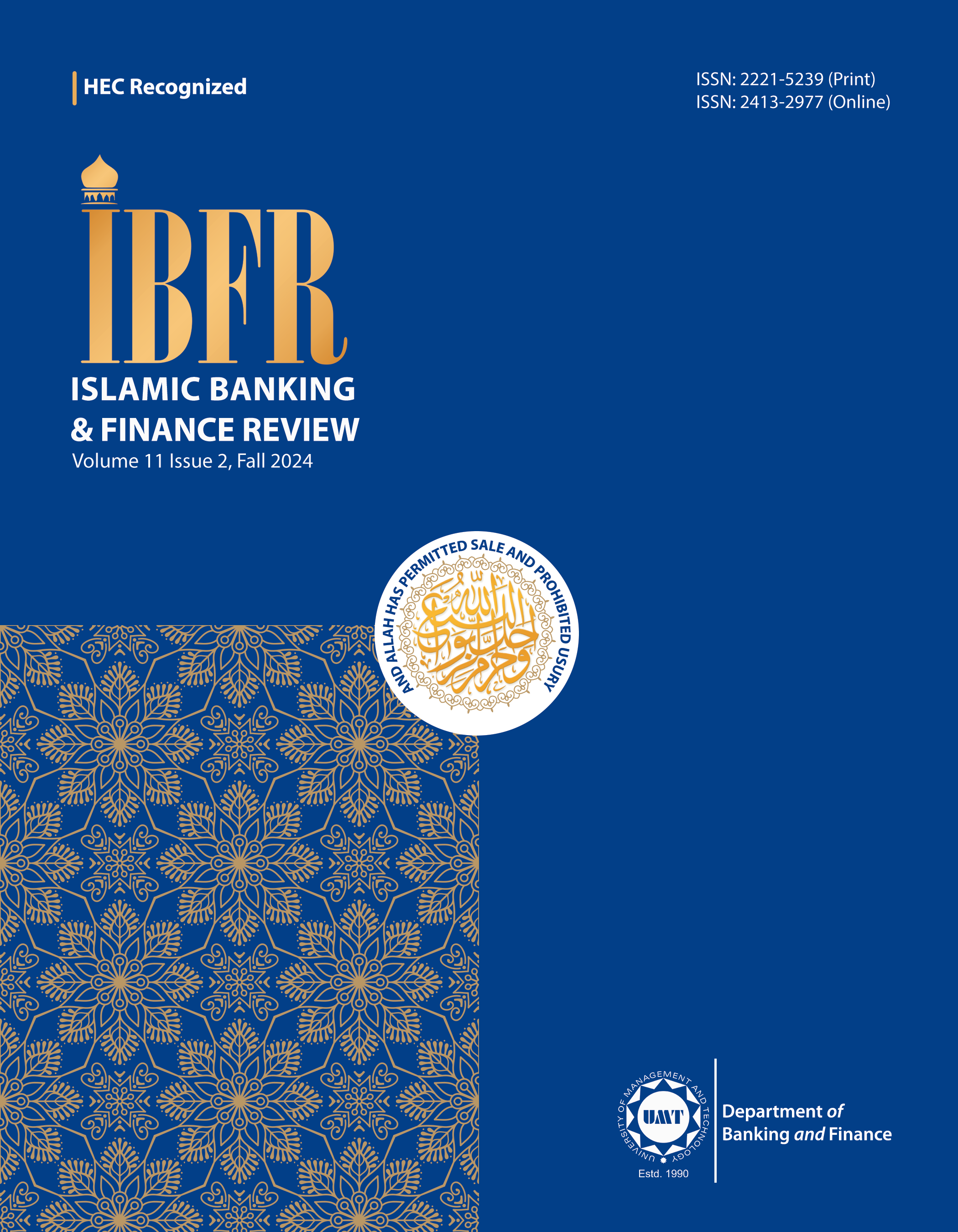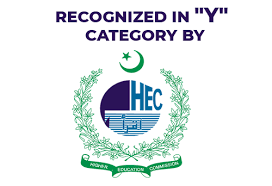Consumer Attitude and Adoption of Islamic Banking in Khyber Pakhtunkhwa, Pakistan: An Empirical Analysis using Structural Equation Modeling
Abstract
 Abstract Views: 0
Abstract Views: 0
The adoption of Islamic banking in Khyber Pakhtunkhwa (KP), a province with a significant rural population and economic challenges, faces unique barriers, such as limited awareness, inadequate financial literacy, and lack of infrastructure. This study aims to analyze the factors influencing customers' intentions toward Islamic banking, using evidence from KP, Pakistan. Primary data was collected from 383 bank customers through a structured closed-ended questionnaire by employing convenience and snowball (non-probability) sampling methods. The dependent variable was the intention to use Islamic banking, while the moderating variable was the attitude toward Islamic banking. The independent variables included customer intimacy, awareness, and social influence. SEM was used to assess both direct effects (such as the influence of customer intimacy and social influence on attitude) and moderating effects (such as how attitude moderates the relationship between awareness and the intention to use Islamic banking). The results indicate that customer intimacy and social influence are statistically significant and positively correlated with the moderating variable, that is, attitude toward Islamic banking. However, awareness, while positively correlated with the attitude toward Islamic banking, remains statistically insignificant. This insignificance may be attributed to several factors, such as the general lack of targeted campaigns or effective educational programs on Islamic banking products, or the entrenched preference for conventional banking systems in the region. It is possible that the awareness of Islamic banking is not sufficiently deep or specific to influence customers' attitudes and intentions significantly. The study suggests that Islamic banks (IBs) in KP should focus on customer intimacy through personalized services and building strong relationships and may leverage social influence from family and peers.
Downloads
References
Ajzen, I., & Fishbein, M. (1975). A Bayesian analysis of attribution processes. Psychological bulletin, 82(2), 261.
Akhtar, N., Mehmood, M. T., Pervez, M. Z., Aslam, F., & Akhtar, H. M. A. (2016). Factors influencing the perception of customers in Islamic banking: a case study in Pakistan. International Review of Management and Business Research, 5(3), 844.
Akhtar, S. (2007). Pakistan Islamic banking–past, present and future outlook. SBP, Karachi, Pakistan.
Akhter, W., Raza, A., & Akram, M. (2011). Efficiency and performance of Islamic Banking: The case of Pakistan. Far East Journal of Psychology and Business, 2(2), 54-71.
Almossawi, M. (2001). Bank selection criteria employed by college students in Bahrain: an empirical analysis. International journal of bank marketing, 19(3), 115-125.
Amin, H., Rahman, A. R. A., Sondoh, S. L., & Hwa, A. M. C. (2011). Determinants of customers' intention to use Islamic personal financing: The case of Malaysian Islamic banks. Journal of Islamic Accounting and Business Research, 2(1), 22-42.
Amin, H., Rahman, A. R. A., Sondoh, S. L., & Hwa, A. M. C. (2011). Determinants of customers' intention to use Islamic personal financing: The case of Malaysian Islamic banks. Journal of Islamic Accounting and Business Research, 2(1), 22-42.
Amin, M., & Isa, Z. (2008). An examination of the relationship between service quality perception and customer satisfaction: A SEM approach towards Malaysian Islamic banking. International Journal of Islamic and Middle Eastern Finance and Management, 1(3), 191-209.
Anwar, M. (2014). Factors Influencing Profitability of Islamic Banking in Kenya; Case of Gulf African Bank (Doctoral dissertation, Kabarak University).
Awan, H. M., & Shahzad Bukhari, K. (2011). Customer's criteria for selecting an Islamic bank: evidence from Pakistan. Journal of Islamic marketing, 2(1), 14-27.
Baloch Asif, M., Shah, F., Afeef, M., & Ahmed, Z. (2016). Factors determining the attitude of customers towards Islamic banking: A study of Peshawar, Pakistan. Abasyn Journal of Social Sciences, 9(1).
Byrne, B. M. (2013). Structural equation modeling with Mplus: Basic concepts, applications, and programming. routledge.
EL Hajjar, S. T., & Alkhanaizi, M. S. (2018). Exploring the factors that affect employee training effectiveness: A case study in Bahrain. Sage Open, 8(2), 2158244018783033.
El Nagar, H. M., & El Biely, M. M. (2011). A comparison of banking behaviour of Islamic bank customer some evidence from Egypt and the Kingdom of Saudi Arabia. International Journal of Economics & Financial Studies, 1(1), 1-14.
Faisal, M., Akhtar, A., & Rehman, A. (2014). Awareness of Islamic banking in India: an empirical study. International Journal of Engineering and Management Research, 7(6), 1-13.
Farooq, S. U., Ahmad, G., & Jamil, S. H. (2010). A profile analysis of the customers of Islamic banking in Peshawar, Pukhtunkhwa. International journal of Business and Management, 5(11), 106.
Fields, S. K., Mahan, P., Tillman, P., Harris, J., Maxwell, K., & Hojat, M. (2011). Measuring empathy in healthcare profession students using the Jefferson Scale of Physician Empathy: health provider–student version. Journal of interprofessional care, 25(4), 287-293.
Gait, A., & Worthington, A. (2008). An empirical survey of individual consumer, business firm and financial institution attitudes towards Islamic methods of finance. International Journal of Social Economics, 35(11), 783-808.
Hair Jr, J. F., Hult, G. T. M., Ringle, C. M., Sarstedt, M., Danks, N. P., & Ray, S. (2021). Partial least squares structural equation modeling (PLS-SEM) using R: A workbook (p. 197). Springer Nature.
Hin, C. W., Wei, C. C., Bohari, A. M., Adam, M. A., & Zainol, M. (2011). Bank selection criteria and service quality of Islamic banking: A comparison between Muslim and non-Muslim students and its effect on student’s satisfaction. Jurnal Ekonom, 14(3), 104-114.
Jabaly, R., Al Ameri, S., & Ghoul, W. A. (2013). Islamic banks’ marketing and communication tactics: towards a better reception and perception. Journal of Islamic Economics, Banking and Finance, 9(3), 149-176.
Jati Kasuma, A. (2012). The effects of ethnicity and religiosity on loyalty of micro-enterprise owenrs' towards banks: an application in Malaysia (Doctoral dissertation).
Javalgi, R. G., Armacost, R. L., & Hosseini, J. C. (1989). Using the analytic hierarchy process for bank management: Analysis of consumer bank selection decisions. Journal of Business Research, 19(1), 33-49.
Keller, G. (2018). Statistics for management and economics. Cengage Learning.
Klarner, P., Sarstedt, M., Hoeck, M., & Ringle, C. M. (2013). Disentangling the effects of team competences, team adaptability, and client communication on the performance of management consulting teams. Long range planning, 46(3), 258-286.
Lada, S., Tanakinjal, G. H., & Amin, H. (2009). Predicting intention to choose halal products using theory of reasoned action. International journal of Islamic and Middle Eastern finance and management, 2(1), 66-76.
Manzoor, M. M., Aqeel, M., & Sattar, A. (2010). Factors paving the way towards Islamic banking in Pakistan. World Academy of Science, Engineering and Technology, 66, 1677-1683.
Marimuthu, M., Chan, W. J., Lim, P. G., Low, P. M., & Tan, Y. P. (2010). Islamic banking: selection criteria and implications.
Metawa, S. A., & Almossawi, M. (1998). Banking behavior of Islamic bank customers: perspectives and implications. International journal of bank marketing, 16(7), 299-313.
Mindra, R., Bananuka, J., Kaawaase, T., Namaganda, R., & Teko, J. (2022). Attitude and Islamic banking adoption: moderating effects of pricing of conventional bank products and social influence. Journal of Islamic Accounting and Business Research, 13(3), 534-567.
Mukhtar, A., & Butt, M. M. (2012). Intention to choose Halal products: the role of religiosity. Journal of Islamic marketing, 3(2), 108-120.
Orhan, K. (2016). Bilimsel Araştırma Yöntemleri. Ekin Kitabevi, Bursa.
Ramayah, T., & Razak, D. A. (2008). Factors influencing intention to use diminishing partnership home financing. International Journal of Islamic and Middle Eastern Finance and Management, 1(3), 235-248.
Rashid, M., & Hassan, M. K. (2009). Customer demographics affecting bank selection criteria, preference, and market segmentation: study on domestic Islamic banks in Bangladesh. International journal of Business and Management, 4(6).
Raykov, T., & Marcoulides, G. A. (2012). A first course in structural equation modeling. routledge.
Riaz, U., Khan, M., & Khan, N. (2017). An Islamic banking perspective on consumers’ perception in Pakistan. Qualitative Research in Financial Markets, 9(4), 337-358.
Riaz, U., Khan, M., & Khan, N. (2017). An Islamic banking perspective on consumers’ perception in Pakistan. Qualitative Research in Financial Markets, 9(4), 337-358.
Riggall, J. (1980). A new study: how newcomers select banks. American Bankers Association Banking Journal, 72(7), 93-4.
Robson, C. (2002). Real world research: A resource for social scientists and practitioner-researchers. Wiley-Blackwell.
Usmani, O. (2015). State Bank of Pakistan--Fueling the Growth of Islamic Banking in Pakistan. Journal of Islamic Banking & Finance, 32(2).
Yu, C. S. (2012). Factors affecting individuals to adopt mobile banking: Empirical evidence from the UTAUT model. Journal of electronic commerce research, 13(2), 104.
Zakir Hossain, M. (2009). Why is interest prohibited in Islam? A statistical justification. Humanomics, 25(4), 241-253.
Copyright (c) 2024 Jawad Khan

This work is licensed under a Creative Commons Attribution 4.0 International License.
Authors retain copyright and grant the journal right of first publication with the work simultaneously licensed under a Creative Commons Attribution (CC-BY) 4.0 License that allows others to share the work with an acknowledgement of the work’s authorship and initial publication in this journal.












